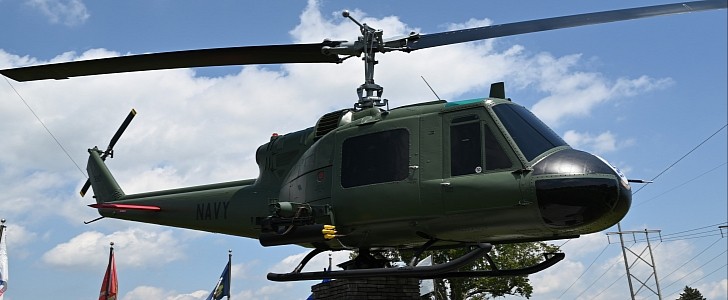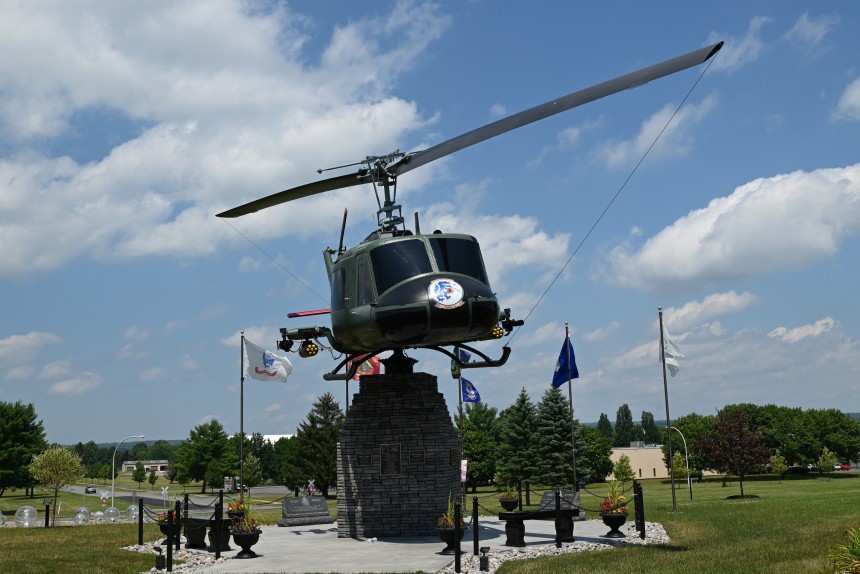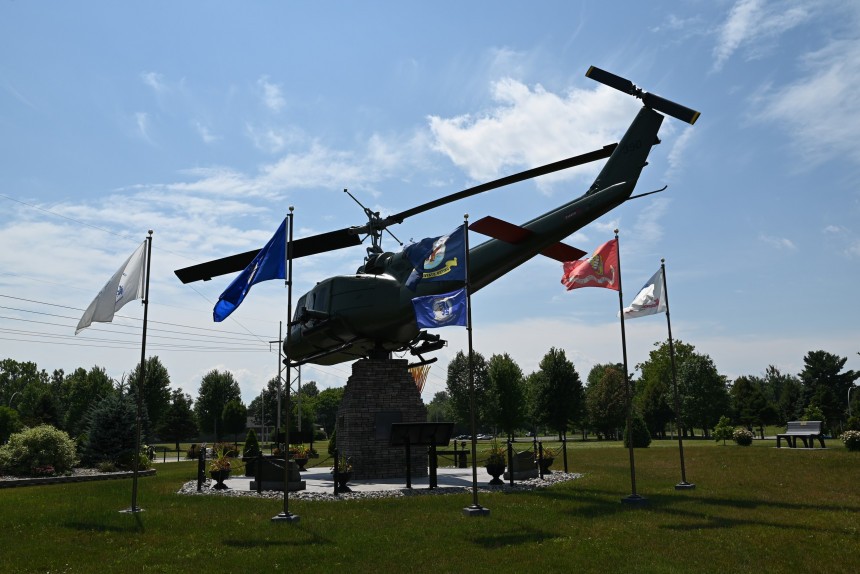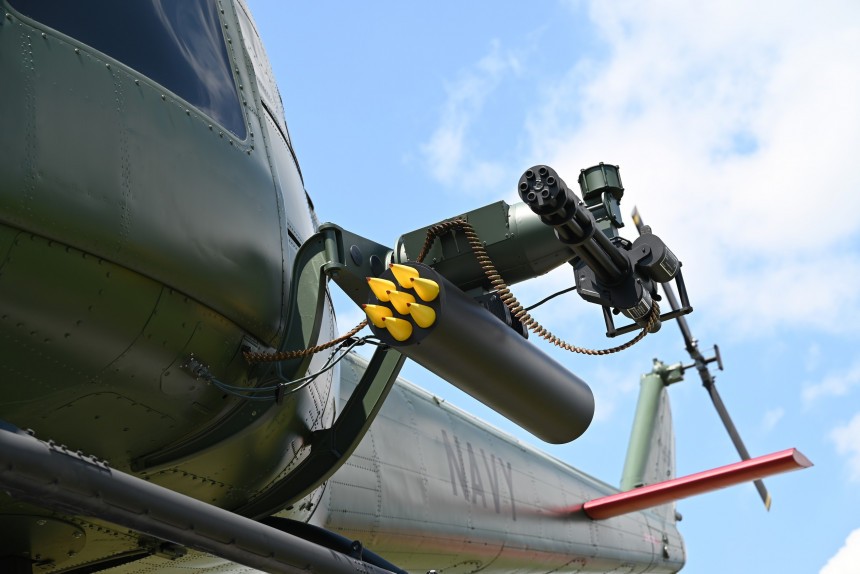A few months ago, we showed you a collection of barnfind condition U.S. Army Bell UH-1 Iroquois helicopters from the Vietnam War in the collection of a lovely museum in Western Pennsylvania. One that we desperately wished someone would scoop up and bring back from the dead.
Well, if our wish were ever granted, the result would look like something like this. Almost 400 miles northeast of the Air Heritage Museum, sits a fully restored and certifiably wicked-looking Bell UH1 Iroquois. But it's not like anyone uses this iconic military chopper's given name. Those who admire them tend to refer to them by their nickname, the "Huey."
The Bell UH-1 generally doesn't need an introduction, but for the sake of a good story, let's give it one anyway. It'll all show how this fully restored example is so special. The Huey's designer, Bell Helicopter, stands alongside their lifelong rivals at Sikorsky as the two foremost innovators in American military helicopters. Both companies transitioned away completely from fixed-wing aircraft production during the second half of the 20th century.
This grand switch in direction is the genesis of the Huey helicopter. In the post-World War II years, the United States Military determined that traditional piston-powered helicopters from the last days of the war and through Korea were underpowered, expensive to maintain, and too large for their limited carrying capacity. It was more than evident by the end of the Korean war in 1953 that some form of turbine-engined utility helicopter was the only solution.
In truth, as many as 20 companies submitted design proposals were sent to the Pentagon's top brass before Bell presented a variant of their Model 47 piston-engined helicopter modified with a Continental CAE XT51-T-3 turboshaft engine. Impressed by the results, Pentagon awarded Bell Helicopter a contract to produce an all-new prototype turbine utility helicopter for the next generation of American soldiers.
The first result of this initiative was the original prototype for the UH-1, called the XH-40. Even before the first flight, the Army ordered a production run of six further prototypes designated the YH-40. When the Army found prototypes to be everything they were looking for and more, they ordered 100 production models. A civilianized variant was developed soon after and went into service as the Bell 204 and the elongated 205.
This order of 100 units was the first of a lineage of 16,000 examples. 5,000 would see extended service in Vietnam as everything from an airborne ambulance, troop and cargo transport, and even an aerial gunship, as is evident by the ample weaponry present on this restored Huey on the grounds of the old Grifiss Air Force Base. In actuality, this particular Huey served in the Royal Australian Air Force before its days as the centerpiece of a war memorial.
After its days with the Aussies, the aircraft was purchased and used as a crop duster by a California company. There, it sprayed pesticides and insecticides onto produce crops in service of a state with the largest production of fresh fruits and vegetables before being acquired by the New York State Vietnam Veterans Memorial Fund sometime in 2020. Sadly, the global health crisis put a stop to all restoration efforts for a period.
As soon as it was able to resume, work began removing any exterior trace of what this Huey looked like during its days in Australia and California. Once that was complete, the helicopter was repainted in a historically accurate depiction of the Helicopter Attack Squadron (Light) 3 (HA(L)-3) that served with the U.S. Navy between April 1967 and March 1972. It comes complete with a similar array of weaponry consisting of two 2.75" 24-Tube rocket launchers and twin 20 mm M61 Vulcan machine guns, one on either wing for both.
Hueys also sometimes flew into battle armed with everything from the M129 40mm grenade launcher to the AGM-22 air-to-ground missile, among countless others. With the complete restoration complete and an entire suite of memorials and plaques dedicated to locals in and around Oneida County, New York, who gave their lives during the Vietnam War.
It's all the more poetic considering the location of this memorial, on the grounds near Grifiss International Airport, where an Air Force installation once vital to the training of American pilots in Vietnam once stood. As veterans of Vietnam continue to advance in age, the story of the war stands to fade from living memory in the not-so-distant future. This is the reason monuments such as this one will one day become vitally important.
Despite all that was wrong with the war in Vietnam, it's important to remember that soldiers on both sides of the conflict were still human beings. Perhaps deeply flawed humans in different ways, but humans who were given iconic and remarkable machines to fly around in.
Machines that ensure the memory of North Vietnamese, South Vietnamese, Australian, and American soldiers who fought in this tragic conflict may never fade from this Earth. It's also extremely pretty to look at outside of all of that. All around a pretty wonderful place to spend an afternoon.
Thanks for reading. Be sure to check out more military aircraft profiles and so much more here on autoevolution.
The Bell UH-1 generally doesn't need an introduction, but for the sake of a good story, let's give it one anyway. It'll all show how this fully restored example is so special. The Huey's designer, Bell Helicopter, stands alongside their lifelong rivals at Sikorsky as the two foremost innovators in American military helicopters. Both companies transitioned away completely from fixed-wing aircraft production during the second half of the 20th century.
This grand switch in direction is the genesis of the Huey helicopter. In the post-World War II years, the United States Military determined that traditional piston-powered helicopters from the last days of the war and through Korea were underpowered, expensive to maintain, and too large for their limited carrying capacity. It was more than evident by the end of the Korean war in 1953 that some form of turbine-engined utility helicopter was the only solution.
In truth, as many as 20 companies submitted design proposals were sent to the Pentagon's top brass before Bell presented a variant of their Model 47 piston-engined helicopter modified with a Continental CAE XT51-T-3 turboshaft engine. Impressed by the results, Pentagon awarded Bell Helicopter a contract to produce an all-new prototype turbine utility helicopter for the next generation of American soldiers.
This order of 100 units was the first of a lineage of 16,000 examples. 5,000 would see extended service in Vietnam as everything from an airborne ambulance, troop and cargo transport, and even an aerial gunship, as is evident by the ample weaponry present on this restored Huey on the grounds of the old Grifiss Air Force Base. In actuality, this particular Huey served in the Royal Australian Air Force before its days as the centerpiece of a war memorial.
After its days with the Aussies, the aircraft was purchased and used as a crop duster by a California company. There, it sprayed pesticides and insecticides onto produce crops in service of a state with the largest production of fresh fruits and vegetables before being acquired by the New York State Vietnam Veterans Memorial Fund sometime in 2020. Sadly, the global health crisis put a stop to all restoration efforts for a period.
As soon as it was able to resume, work began removing any exterior trace of what this Huey looked like during its days in Australia and California. Once that was complete, the helicopter was repainted in a historically accurate depiction of the Helicopter Attack Squadron (Light) 3 (HA(L)-3) that served with the U.S. Navy between April 1967 and March 1972. It comes complete with a similar array of weaponry consisting of two 2.75" 24-Tube rocket launchers and twin 20 mm M61 Vulcan machine guns, one on either wing for both.
It's all the more poetic considering the location of this memorial, on the grounds near Grifiss International Airport, where an Air Force installation once vital to the training of American pilots in Vietnam once stood. As veterans of Vietnam continue to advance in age, the story of the war stands to fade from living memory in the not-so-distant future. This is the reason monuments such as this one will one day become vitally important.
Despite all that was wrong with the war in Vietnam, it's important to remember that soldiers on both sides of the conflict were still human beings. Perhaps deeply flawed humans in different ways, but humans who were given iconic and remarkable machines to fly around in.
Machines that ensure the memory of North Vietnamese, South Vietnamese, Australian, and American soldiers who fought in this tragic conflict may never fade from this Earth. It's also extremely pretty to look at outside of all of that. All around a pretty wonderful place to spend an afternoon.














